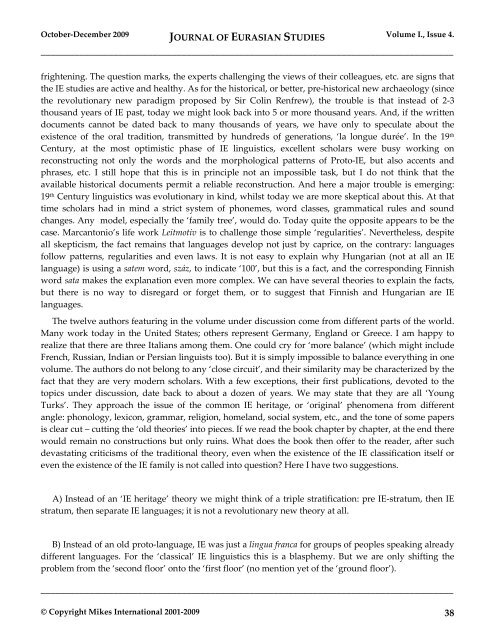JOURNAL OF EURASIAN STUDIES
JOURNAL OF EURASIAN STUDIES
JOURNAL OF EURASIAN STUDIES
You also want an ePaper? Increase the reach of your titles
YUMPU automatically turns print PDFs into web optimized ePapers that Google loves.
October-December 2009 <strong>JOURNAL</strong> <strong>OF</strong> <strong>EURASIAN</strong> <strong>STUDIES</strong> Volume I., Issue 4.<br />
_____________________________________________________________________________________<br />
frightening. The question marks, the experts challenging the views of their colleagues, etc. are signs that<br />
the IE studies are active and healthy. As for the historical, or better, pre-historical new archaeology (since<br />
the revolutionary new paradigm proposed by Sir Colin Renfrew), the trouble is that instead of 2-3<br />
thousand years of IE past, today we might look back into 5 or more thousand years. And, if the written<br />
documents cannot be dated back to many thousands of years, we have only to speculate about the<br />
existence of the oral tradition, transmitted by hundreds of generations, ‘la longue durée’. In the 19 th<br />
Century, at the most optimistic phase of IE linguistics, excellent scholars were busy working on<br />
reconstructing not only the words and the morphological patterns of Proto-IE, but also accents and<br />
phrases, etc. I still hope that this is in principle not an impossible task, but I do not think that the<br />
available historical documents permit a reliable reconstruction. And here a major trouble is emerging:<br />
19 th Century linguistics was evolutionary in kind, whilst today we are more skeptical about this. At that<br />
time scholars had in mind a strict system of phonemes, word classes, grammatical rules and sound<br />
changes. Any model, especially the ‘family tree’, would do. Today quite the opposite appears to be the<br />
case. Marcantonio’s life work Leitmotiv is to challenge those simple ‘regularities’. Nevertheless, despite<br />
all skepticism, the fact remains that languages develop not just by caprice, on the contrary: languages<br />
follow patterns, regularities and even laws. It is not easy to explain why Hungarian (not at all an IE<br />
language) is using a satem word, száz, to indicate ‘100’, but this is a fact, and the corresponding Finnish<br />
word sata makes the explanation even more complex. We can have several theories to explain the facts,<br />
but there is no way to disregard or forget them, or to suggest that Finnish and Hungarian are IE<br />
languages.<br />
The twelve authors featuring in the volume under discussion come from different parts of the world.<br />
Many work today in the United States; others represent Germany, England or Greece. I am happy to<br />
realize that there are three Italians among them. One could cry for ‘more balance’ (which might include<br />
French, Russian, Indian or Persian linguists too). But it is simply impossible to balance everything in one<br />
volume. The authors do not belong to any ‘close circuit’, and their similarity may be characterized by the<br />
fact that they are very modern scholars. With a few exceptions, their first publications, devoted to the<br />
topics under discussion, date back to about a dozen of years. We may state that they are all ‘Young<br />
Turks’. They approach the issue of the common IE heritage, or ‘original’ phenomena from different<br />
angle: phonology, lexicon, grammar, religion, homeland, social system, etc., and the tone of some papers<br />
is clear cut – cutting the ‘old theories’ into pieces. If we read the book chapter by chapter, at the end there<br />
would remain no constructions but only ruins. What does the book then offer to the reader, after such<br />
devastating criticisms of the traditional theory, even when the existence of the IE classification itself or<br />
even the existence of the IE family is not called into question? Here I have two suggestions.<br />
A) Instead of an ‘IE heritage’ theory we might think of a triple stratification: pre IE-stratum, then IE<br />
stratum, then separate IE languages; it is not a revolutionary new theory at all.<br />
B) Instead of an old proto-language, IE was just a lingua franca for groups of peoples speaking already<br />
different languages. For the ‘classical’ IE linguistics this is a blasphemy. But we are only shifting the<br />
problem from the ‘second floor’ onto the ‘first floor’ (no mention yet of the ‘ground floor’).<br />
_____________________________________________________________________________________<br />
© Copyright Mikes International 2001-2009 38
















